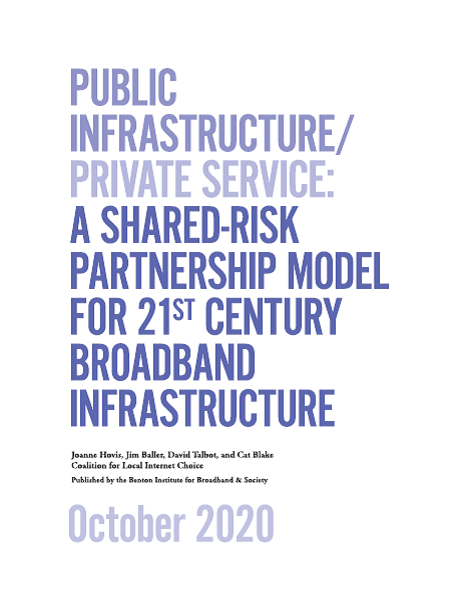David Talbot

How Can America’s Communities Secure the Benefits of Fiber-Optic Infrastructure?
How can America’s communities secure the benefits of fiber-optic infrastructure? Our answer is that local governments need not accept a binary option of waiting for the private sector to solve the problem—which the private sector already would have done if it made business sense—or taking on the challenge entirely as a public enterprise. Rather, public-private collaboration can disrupt this binary and give communities options.

Public Infrastructure/Private Service Model For 21st Century Broadband Proves Worthy
The emerging model presents a scalable option for communities that lack the expertise or interest to operate networks or act as ISPs themselves but want to own and control the core communications assets in their communities as a means of securing the benefits of broadband internet. Here’s a look at the model’s business case, technical elements and risks.
Public Infrastructure/Private Service: A Shared-Risk Partnership Model for 21st Century Broadband Infrastructure
The Public Infrastructure/Private Service model puts the locality in the business of building infrastructure, a business cities and counties know well after a century of building roads, bridges, and utilities. The model leaves to the private sector most aspects of network operations, equipment provisioning, and service delivery. The Public Infrastructure/Private Service model leverages the best capabilities of the public and private sectors.
Private-sector investment alone is not closing our digital gaps. The Public Infrastructure/Private Service model offers a promising solution that is precisely targeted to the areas with greatest broadband gaps, frequently those with lower income levels and lower population densities.


Community-Owned Fiber Networks: Value Leaders in America
By one recent estimate about 8.9 percent of Americans, or about 29 million people, lack access to wired home “broadband” service, which the Federal Communications Commission defines as an internet access connection providing speeds of at least 25 Mbps download and 3 Mbps upload. Even where home broadband is available, high prices inhibit adoption; in one national survey, 33 percent of non-subscribers cited cost of service as the primary barrier. Municipally and other community-owned networks have been proposed as a driver of competition and resulting better service and prices.
The Hole in the Digital Economy
If the next president intends to improve American infrastructure and expand economic opportunities, there’s no better place to start than with the millions of people who still lack broadband access and computer skills.
Does everyone deserve access to affordable high-speed Internet, just like water, sewers, electricity, and telephone service? In Ma’Niyah Larry’s apartment and at the Ashbury Community Center, where Monica Moore rebooted her career, you can see that the argument could be made. “There is never a shortage of people who want to show up here and learn,” Bill Callahan, director of the Connect Your Community collaborative, remarked as we looked around the community center.
Talk of an Internet Fast Lane Is Already Hurting Some Startups
Some venture capitalists at the cutting edge of Internet innovation say they will shun startups requiring fast connections for video, audio, or other services, mindful that the Federal Communications Commission may let Internet service providers (ISPs) charge extra fees to major content providers.
In the absence of clear rules, some ISPs have already begun requesting -- and receiving -- access fees. if deep-pocketed players can pay for a faster, more reliable service, then small startups face a crushing disadvantage, says Brad Burnham, managing partner at Union Square Ventures, a VC firm based in New York City.
“This is absolutely part of our calculus now,” he says. Burnham says his firm will now “stay away from” startups working on video and media businesses. It will also avoid investing in payment systems or in mobile wallets, which require ultrafast transaction times to make sense. “This is a bad scene for innovation in those areas,” Burnham says of the FCC proposal.
Now Your Phone’s Tilt Sensor Can Identify You
The sensor that lets your phone know which way the screen is oriented also -- thanks to minute manufacturing variations -- emits a unique data “fingerprint” that could allow your phone to be tracked, even if all other privacy settings are locked down, researchers say.
In addition to governing basic things like screen orientation, accelerometer data is widely used by apps such as pedometers and mobile games. Meanwhile, many apps often rely on advertising, which has led advertisers to search for ways to track users and their Web habits.
Even if you don’t allow apps to see your personal data or location, just the raw movements of the phone -- which can be measured without permission -- can betray the phone’s unique identity and track it over time, says Romit Roy Choudhury, an associate professor at the University of Illinois who cowrote a paper with colleagues at the University of South Carolina that describes the phenomenon.
“There has been a lot of work to catch the leakage of ID information from phones,” he says. “We are now saying that accelerometer data going out of the phone can be treated as an ID.”
A Net Neutrality Riddle
[Commentary] Here’s an interesting way to look at the often abstract topic of “net neutrality.”
Let’s say you are an online storage vault like Carbonite or Dropbox. Now, further assume that your company’s major technical activity is data inhalation. Petabytes of pictures, video, and so forth are uploaded to your servers every day. And you can’t help noticing that the major sending party is a Comcast, the giant Internet service provider (ISP). Outrageous. They’re paid by their customers, and now they are sending you all of this data, forcing you to upgrade your connections to handle the upload volume.
So in addition to whatever subscriptions you charge your customers, shouldn’t you also charge Comcast a toll for sending you all that traffic? It’s an absurdity. But it’s an intriguing piece of the argument that Netflix CEO Reed Hastings articulated.

